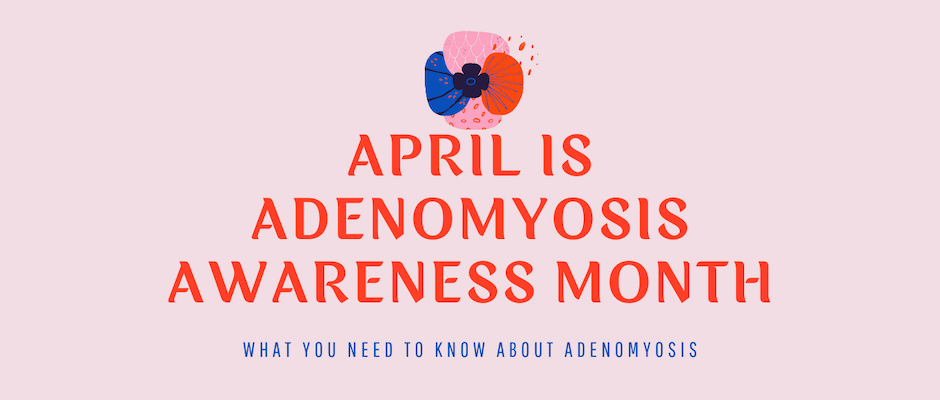
A few years ago, 25-year-old Charlotte had not even heard of adenomyosis. Now, she appreciates that the gynecological condition is much more than just a “bad” period. “A lot of people dread their periods; but there’s not a single minute of any day when I’m not in pain.”
Adenomyosis is a common, often painful condition where cells from the inner lining of the uterus (the endometrium) infiltrate the muscular layer of the uterus (the myometrium). The endometrial cells thicken and shed during the menstrual cycle, damaging blood vessels in the myometrium and creating pockets of blood in the muscle wall.
Common symptoms include painful periods, heavy or irregular bleeding, and pressure in the lower abdomen or pelvic area. It is estimated that up to one in three women have the condition; although many experience pain, some have no symptoms at all, or assume that their heavy periods are normal.
For those who do experience symptoms, however, the condition encroaches on all aspects of daily life. Lisa, 48, developed cramping pain and heavy bleeding in her 20s, after years of symptomless periods.
“It felt like a tugging sensation inside. A stabbing pain that made every movement painful. My daily life was heavily affected. I had three children and two stepchildren to look after, but most days I just wanted to stay in bed.”
Kia, 42, had such heavy periods that she became anemic. “I needed a blood transfusion and regular iron infusions. I was tired all the time and in excruciating pain during my periods. Looking back, I don’t know how I coped.”
Sufferers of adenomyosis often have an enlarged uterus due to the abnormal thickening of the myometrium. Experts are unsure whether adenomyosis directly affects fertility; displacement of normal tissue and abnormal blood flow within the endometrium have the potential to cause problems with conceiving and carrying a baby.
A 2005 study found that 79% of women with fertility issues had both endometriosis and adenomyosis; the similarity between the two conditions in terms of symptoms often makes it difficult to determine the root cause. Endometriosis and adenomyosis often appear together, but there is currently no evidence to suggest that either condition causes the other.
Despite experiencing such severe symptoms, Lisa and Kia, like many sufferers, spent years searching for a diagnosis. Adenomyosis is notoriously difficult to diagnose, due to the similarity of its symptoms with other conditions, a lack of awareness among medical professionals, and many women’s acceptance that “bad” periods are normal.
According to consultant gynecologist Dr. Narenda Pisal, women have been conditioned to put up with debilitating menstrual cycles. “Women don’t often know how heavy or painful their periods are supposed to be,” he says.
Until recently, the condition could only be diagnosed retrospectively, through microscopic analysis of a uterine tissue after a hysterectomy. Although examination through pathology is considered to be the gold standard of diagnosis, advances in imaging now mean that internal ultrasounds and MRI scanning can be used to detect adenomyosis in the majority of cases as well.
Dr. Pisal says that these advances are reasons to be hopeful: “A higher detection rate and early diagnosis will aid prompt treatment and improve the quality of life for many women.”
Anecdotally, however, many sufferers say that doctors lacking specialist knowledge can lead to misdiagnosis, while others say their symptoms are not taken seriously.
Charlotte was told for years that her symptoms were due to irritable bowel syndrome (IBS) or appendicitis.
“The last straw for me was being told that it was “just” period pain,” she says. “I started my period at 13; I'd been having them for 10 years. I knew what my periods felt like and that this was something different. Something in my body had changed.”
“I really had to push for them to investigate further. After the pain got so bad that I had to miss days off work, my parents helped me find a gynecologist. She took one look at my history and symptoms and said it was most likely endometriosis or adenomyosis. I’d never heard of adenomyosis until then.”
Esther, 23, also feels that she should have been referred to a gynecologist sooner.
“Now that I’ve got a diagnosis, doctors are listening to me. Getting to that stage and convincing them that there was something wrong with me was hard. They were trying to pass off my symptoms as conditions that had no relation to what I was experiencing. It really was a battle.”
Campaigners for gender equality will point to lack of research and treatment for gynecological conditions as a consequence of the “gender pain gap,” an unconscious bias in medicine that invalidates women’s experiences.
A study by the University of Maryland, ‘The Girl Who Cried Pain’, revealed that healthcare professionals will believe men who say they are in pain, but are more likely to view women’s pain as psychosomatic.
Esther says she felt gaslighted when no one believed her: “After trying and failing so many times to convince them that there was something wrong with me, I started to doubt myself.”
There is no known cause or cure for adenomyosis, besides having a hysterectomy. Some experts believe that adenomyosis occurs in uteruses that have experienced muscle trauma, such as a cesarian (C-section), which would allow endometrial tissue to migrate to the muscle wall. This would explain why the condition often appears later in a woman’s reproductive years. A hysterectomy may be offered as a last resort, especially to older women who feel they have completed their childbearing plans.
Younger women who have not had children sometimes choose a hysterectomy simply because all other options have failed. Kristin, 35, says she was prescribed opioids for the pain and antidepressants for the emotional strain.
“There came a time when I could not increase those medications anymore, and my quality of life was suffering greatly. I chose a hysterectomy and would do it over again in an instant. Two years on and I’m thriving.”
Most sufferers choose to manage their symptoms with pain-relievers or hormone treatment. A hormone-releasing intrauterine device (IUD), which is a small plastic T-shaped device placed in the uterus, may be recommended to reduce heavy bleeding, as well as hormonal treatments that will lighten periods and stop the full menstrual cycle from occurring, such as birth control pills or high-dose progesterone. Strong analgesics may also be recommended for the pain, such as high-dose ibuprofen or naproxen.
Charlotte experiences debilitating back pain along with regular cramps which affect her ability to carry out basic tasks. “I take mefenamic acid every day and have just started tramadol. The painkillers allow me to get up and do things but they don’t stop it completely. Sometimes I'll get up, do the washing up, tidy the house, and then I feel physically broken. But then what other choice do I have?”
Charlotte worries about how she will cope when she has to go back into the office. “As I’ve been working from home, I have a heat pack, hot water bottle, and TENS machine all strapped to me at once.”
Other options, such as the Lupron injection, come with their own extreme downsides thus are not a preferred therapy. Hormone injections induce a temporary, reversible menopause which thins the womb lining and stops the patient’s menstrual cycle completely.
This may relieve symptoms of adenomyosis, but causes side-effects common during menopause, such as depression, mood swings, and hot flashes. The injection cannot be used as a long-term solution as it risks bone loss and osteoporosis.
Uterine artery embolization (UAE) is another treatment option. According to Dr. Pisal, “UAE is usually reserved for fibroids but is also very effective for treating adenomyosis. The uterine blood supply is blocked by an interventional procedure carried out through the groin blood vessels.” This method of treatment is minimally invasive but may require repeat procedures.
The lack of a cure or a sustainable, long-term solution leaves many adenomyosis patients struggling to cope. Before having a hysterectomy, Lisa experienced severe anxiety and depression. “I cried for myself but also for my children because I couldn’t be there for them like I wanted to be.”
Kristin also struggles with her mental health: “The trauma from decades of chronic pain is real and profound. Doctors can try to address the physical aspect, but understanding the whole impact is another story.”
Many sufferers have found solace in online support groups. Lisa started a blog to document her experiences, while Charlotte and Esther have set up Instagram accounts.
“There is a lot more awareness about endometriosis these days but not enough about adenomyosis,” says Esther. “On Instagram, half the women I talk to who are experiencing the same symptoms as me haven’t even heard about adenomyosis.”
Kristin agrees that community support is vital: “I’ve found it best to get support from people who have lived it, who truly understand.”
What stands out is the resilience of adenomyosis sufferers. “Having the condition made me feel powerless,” says Kristin. “It took a huge chunk of my life from me, but it also showed me how strong I am. Now that I've had my hysterectomy, I’m committed to helping other sufferers of chronic pain rebuild their lives.”









